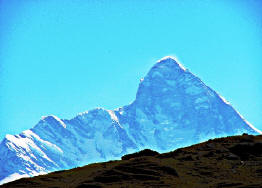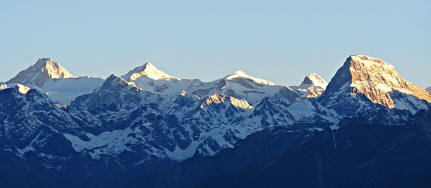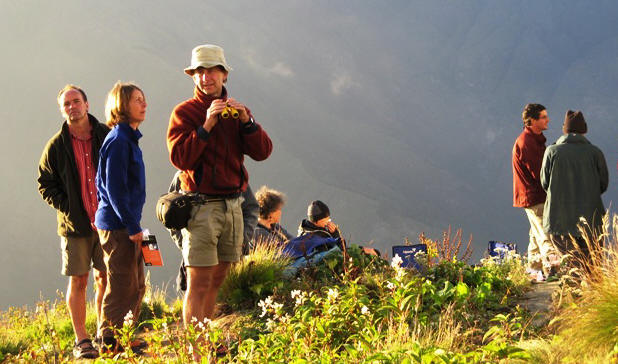 |
 |
 |
 |
 |
 |
|
||||
|---|---|---|---|---|
Nandadevi Sanctuary Facts Area : 630 sq km. :
Nanda Devi Altitude : 2100 metre to 7817 m. above sea
level
Nandadevi Annual Mean Rainfall : 1800.2 mm :
Nanda DeviLanguages : Hindi, Garhwali, English
Nandadevi Best Time to Visit : May to end of October
Dominating the Garhwal & Kumaon Himalaya is the Nanda Devi Group of mountains
with Nanda Devi (7,816 m), named after the all-encompassing form of the female
deity, at its centre. It is an incredibly beautiful mountain of two peaks
separated by a 4 km long ridge.
The legend : Legend has it that the hand of Nanda Devi ("She who gives bliss"), daughter of a local king, was demanded in marriage by a marauding prince. War ensued, her father was killed & she fled, eventually finding refuge on top of the mountain, now bearing her name. She is protected by a ring of mountains 112 km in circumference containing 12 peaks over 6,400, in height & in only one place is this defensive ring lower than 5,500 m, at the Rishi Gorge, one of the deepest in the world. It is the place for sages (rishi).
Nanda Devi Biosphere Reserve is distinct for its rich bio-diversity and its pristine scenic beauty. A paradise for nature lovers and wildlife enthusiasts.
NANDA DEVI NATIONAL PARK (Core - I) : -
The Nanda Devi National Park is the first and
foremost core of the NDBR and most valued property. It has an area of 624.6
Sq. Km. and has an average altitude exceeding 4500m to 5200m, is surrounding
by high mountains ridges and peaks on all side except its western side, which
features a deep and virtually inaccessible gorge. Some of the important peaks
encircling the Park are Dunagiri (7066m), Changbang (6864m), Kalanka (6931m),
Rishi Pahar (6992m), Mangraon (6765m), Nanda Khat (6631m), Maiktoli (6803m),
Mrigthuni (6655m), Trishul - I , II , III (7120m), Beathartoli Himal (6352m),
Nanda Devi east (7434m), Nanda Devi main (7817m), Devisthan I, II (6529) and
Hanuman (6070m) peaks are situated in the park. The park is the form of a cup
with lush green meadows , cluttering white water falls, and rich wild flora
and fauna. Fauna includes Snow leopard , Himalayan Bear, Musk- deer and
Pheasant. Flora like Brahma-Kamal and Bharal (blue mountain goat) make this -
a Sanctuary of Nature.
In 1982, access to trekkers into the Nanda Devi National Park was banned to
protect its biodiversity. The Nanda Devi National Park which has been declared
"world heritage site" has been partially opened recently numbers of tourist.
This area has
attracted many prominent International mountaineers. Sir Edmund Hillary in his
autobiography has mention the ruggedness of this Sanctuary.
"Nanda Devi Sanctuary is God gifted wilderness , India 's training ground for
adventure……"
In 1936, while Shipton was engaged on everest, Tilman and a group of American
mountaineers made the first successful ascent of Nanda Devi, before exiting
via the Long Staff Col to the Gori Ganga.
Region : Garhwal Himalayas
Duration : 10 / 12 Days.
Altitude : Max.. 5000m.
Grade : Difficult
Place covered : Rishikesh (340) : Joshimath (1890m) : Suraithota
(2161m) : Tolma (3750m) : Jhandidhar (3880m) : Dharansi Pass (4250) :
Deberugheta (3500m).
Location : The Nanda Devi National Park is located in the Indian state of Uttaranchal in the upper Himalayan ranges. A part of the Garhwal Himalayas, the park extends from the latitude 30°24' in the North to the longitude 79°53' in the East. The entry to the park is from Lata village around 23 km from Joshimath. Mountain peaks surround it from all sides except the west where it is bounded by an inaccessible gorge.
Climate : Being in the high altitudes, Nanda Devi National Park has a distinct climate. For six months of the year, the region remains under a snow cover. For the rest of the year, the region has a dry climate with heavy rainfall from June to August. April to June are the months when the temperature increases a bit and they are the months when one can visit this place. Flora : The forest cover in this park is mainly restricted to the Rishi Gorge and the main vegetation is of fir, birch, rhododendron, and juniper. In the inner sanctuary, conditions are drier and near the Nanda Devi Glacier , there is almost no vegetation. From Ramani , the vegetation changes to alpine and only juniper scrubs are the dominating vegetation. The Juniper scrubs gradually give way to grasses, prone mosses, and lichens.In total, 312 floral species have been found here of which around 17 are considered rare.
Fauna : Animal population of species like bharal, Himalayan tahr, serow, goral, snow leopard, Himalayan black bear, brown bear, leopard, common langur, Himalayan musk deer , and brown beer dominate the park area. Warblers, gresbreaks, rose finches, and ruby throat represent avifauna here. Approximately 80 species have been spotted in this park.
VISITOR'S NUMBER & MOVEMENT : The visitors will move in groups. Each group will consist of maximum of five visitors. Not more than two groups are permitted in one day and not more than four groups will be permitted in one week. One registered guide will accompany every five visitors. Visitors only above 14 years will be allowed to go inside the park. It will be mandatory for all the tourists to obey and observe all the provisions of wildlife protection act inside the park area.
DAY 01. ARRIVE
RISHIKESH
Arrive Rishikesh . Met upon arrival and transfer to hotel . Evening visit the
Ghat s s to encounter evening Ghat life as well as special Arti The Prayer
dedicated to Goddess Ganges the town of ashrams and temples, Ghats and
pilgrims, mountains and the holy Ganges. When global orange sun suspended,
waits low amid the red/yellow streaked horizon, then all these combine to give
this town a very special evening. The temple bells roar, priests enchant
mantras. Immersed in sublimation stand the pilgrims. Cupped leaves, with
saffron marigold petals and a small candle flame, flickering ride the current
of water of wisdom. Suddenly the sky darkens, spreading a blanket of
stillness. Everything stops, except the sound of current, which has just sunk
the tiny flames of cupped leaves, few minutes back. After experiencing above
we trace ours steps back to the hotel. Later briefing about the trek,
introduction with guide & camp staff, Dinner and overnight hotel.
DAY 2 : RISHIKES :
JOSHIMATH : DRIVE 8/9 HRS : OVERNIGHT : HOTEL
Morning after breakfast drive to Joshimath. The entire drive toady is along
the Ganga and Alaknanda River. We stop at Devprayag to visit the confluence at
the beginning of the Ganges. Arrive Joshimath and transfer to hotel. Eveing
visit the hill town. Dinner and overnight hotel.
DAY 3 : JOSHIMATH : Day for obtaining final permission to venture into NDNP from forest authorities, Joshimath. Overnight Hotel.
Day 4 : JOSHIMATH -
TOLMA : DRIVE 3 HRS : TREK 4 HRS : OVERNIGHT - CAMP.
Drive to Suraithota 30 kms from Joshimath, further trek to tolma a tiny
village situated at a altitude of 2680m. the trail till to Tolma is steep ,
while we cross on the way Suraithota and a small stream and a dense forest to
reach our campside, but we are making the camp above the Tolma village. The
camp side is a small flat part inside a forest where a beautiful water stream
is available. Tolma village through the rich forest ot Thuner, Kail, Ddevdar
and Surai. O/N- CAMP.
DAY 5 : TOLMA -
DHARASSI PASS : TREK 7-8 HRS : OVERNIGHT - CAMP
From TOLMA to Satkula and Dharassi pass is steep and rocky. One can have
difficulties after 2 km trek from Satkula when the rocky surface begins to
enter the pass: some equipment brought by the guide and porters shall be
needed to face these types of difficulty. At Satkula one have to cross seven
roaring streams coming from Nanda Devi snow-clapped ranges.
The Pass appears to be a long steep trek with many ascents and descents until
the Nanda Devi comes into the view when crossing the Pass. Dharassi Pass is a
Camp side where water is available. The Pass is inside a huge dense forest
which covers many types of wild animals and birds. There is a beautiful small
meadow from where one can enjoy the Nanda Devi Sanctuary nearly. There are
rich flora & fauna inside the Pass. The Pass beauty is everlasting: the view
is over the Nanda Devi, Donagri, Mrigthuni, Mangraon, Changbang, Kalnka,
Hanuman and many other peaks are seen from here.
The whole Nanda Devi Sanctuary is seen from here. Sir Emund Hillary described
the Sanctuary as a God - Gifted.
DAY 6 : DHARASIPASS -
DIBRUGETHA : TREK 4-5 HRS : OVERNIGHT - CAMP.
If one has luck, he can enjoy the wild animals like black bear, musk deer,
Monal pheasant and many other types of wild animals at Dibrugetha huge forest.
Dibrugetha is inside a huge dense forest, only one can enjoy streams and wild
Flora & Fauna inside the Forest.
Like the inner sanctuary, the prominent Malthuni-Bethartoli ridge, between
Dharansi Pass and Debrugheta, also divides the outer sanctuary. Both these
ridges from magnificent Pass to Rani Kholi and up to Donidhar is a gradual
descent and then from Donidhar to Debrugheta is a steep descent of 750 m till
one cross the improvised bridge over the stream. Afternoon return trek to
Dharansi Pass. Overnight in tent.
DAY 7 : DHARASSI PASS
- LATAKHARAK : TREK 5-6 HRS : OVERNIGHT CAMP / HUT.
From Dharassi Pass to Bagfyana is descend but one have to be very careful
while crossing a roaring stream at Bagfyana, the trail passes through a very
narrow gorge at Satkula. While ascending ans descending we reach to the
capside Latakharak. The camp/hut at Lata Kharak is situated on the height of
3689m and high plateau surrounded by towering rocky Pinnacles. Wake up at down
to breath taking view of Mount Bithartoli-Himal (6354 m), Nanda Ghunti (6309
m), Ranthi Peak (6003 m) Dronagiri (7066 m) and the vast view of Kunwari pass,
Auli, Tapovan and Urgam Valley and Lata Village.
DAY 8 : LATAKHARAK -
LATAVILLAGE - JOSHIMATH : TREK 4-5 HRS : DRIVE 2 HRS.
OVERNIGHT : HOTEL.
Today the trek commands almost descend 1524 m with a break at Belta, the trail
leads through inside the thick forest till Lata Village. Enjoy the Lata
Village temple and their culture. Further trek down to Lata road head where
our coach-jeep will be waiting for us. Drive to Joshimath, visitng on the way
Tapovan (Hot Spring). O/N - Hotel.
DAY 9 - JOSHIMATH -
RISHIKESH: DRIVE 8/9 HRS. OVERNIGHT HOTEL / CAMP.
Live your footprints behind to mountains and trace back your step to Rishikesh.
O/N - Hotel / Camp.
For Further Details and Booking write down us or call us :
Nandadevi Trekking Tours Corporate Office
24 HRS contact number : + 91-
09837937948 / 09759675791
/ 09412439693
CHAT RD : MSN : YAHOO : SKYPE : garhwalhimalaya Visit us: www.nandadevi.in / www.valleyofflowerstrek.in / www.indianhialayas.in "A Luxury Adventure & Travel Destination Team "
|
|||
|
|||
|
Disclaime This Site is Designed, Developed and Promoted by Nandadevi Shepherd Team in High Pass Himalayas |